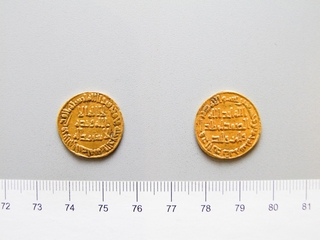Dinar of al-Walid I

Dinar of al-Walid I, Umayyad Caliph, 714 CE
Accession no. 2001.87.884
Yale University Art Gallery
Housed in the Yale University Art Gallery numismatics collection, this 8th-century gold dinar offers an insightful look into converging Byzantine and Islamic cultures during the Umayyad Caliphate. The dinar weighs a market standard of 4.26g in gold and is believed to have been minted in 714 CE under the rule of Al Walid I (r. 705-715), the son of ‘Abd al-Malik (r. 686-705). The coin reads bism Allah la ilah Allah wahdahu Muhammad rasul Allah (“In the name of God there is no god except God alone; Muhammad is the messenger of God”), counterclockwise on the obverse, a change made under Abd al-Malik’s rule. Under the Umayyad Caliphate, numismatics became a tool for unifying the Islamic empire, embedding religious declarations in daily commerce and asserting Islamic identity against Byzantine and Sassanid influences. Abd al-Malik had chosen Quranic verses that were easily recognizable and had been committed to memory by an emerging class of Muslims. This, coupled with the adoption of an exclusively epigraphic coinage that eschewed figural representations in favor of Arabic inscription, solidified Arabic as the lingua franca of Islamic governance and scholarship. The shift in coinage in this time was not an isolated endeavor, but part of a broader wave of architectural and administrative reform aimed at solidifying the Umayyad’s claim to both temporal and spiritual authority.
Sources:
Bacharach, Jere L. “Signs of Sovereignty: The ‘Shahāda, Qur‘anic verses, and the Coinage of ‘Abd Al-Malik.” Muqarnas 27 (2010): 1–30.
Hébert, Raymond J. “The Coinage of Islamic Spain.” Islamic Studies 30, no. ½ (1991): 113–28.
Sears, Stuart D. “Before Caliphal Coins: Transitional drahms of the Umayyad North.” American Journal of Numismatics (1989-) 15 (2003): 77–110.